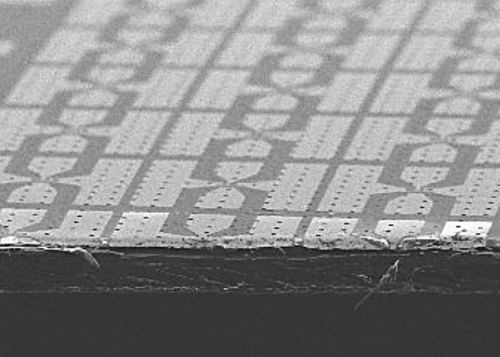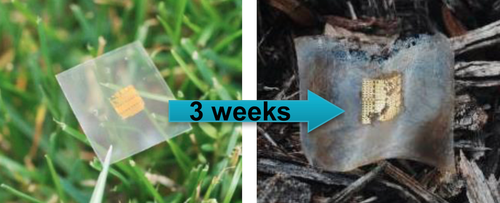
The Electronics TakeBack Coalition (Oakland, Calif.), for instance, estimates that over 55 million tons of old smartphones, personal computers, televisions and other silicon-based devices are discarded each year, only about 14 percent of which are recycled.
But if researchers at the University of Wisconsin-Madison have their way, the same-silicon-based devices will biodegrade in just a few weeks in the environment of a landfill. An additional advantage to these cellulose nano-fibrillated fiber (CNF) substrates is that they are transparent and flexible yet able to handle almost any high-speed (300-MHz to 300-GHz) silicon electronic or radio-frequency circuit transferred to them.
According to professor Zhenqiang (Jack) Ma at the University of Wisconsin-Madison, after transferring single-crystal silicon circuitry to the CNF substrate, their normal lifetime within the smartphone, or other similar electronic device, is the same as if it was left on its original silicon substrate.
"The lifetime of our biodegradable transistors are of no difference from the regular transistors. As long as the transistors are not put into touch with fungi together with moisture, they will not degrade at all," Ma told EE Times. "Their performance is also the same, because our transistors are also made of single crystal silicon. There is no difference at all."
The catch is that semiconductor manufacturers will have to be persuaded to add Ma’s nano membrane process of lifting the silicon circuitry from its native substrate and redeposit it on the CNF substrates–no easy task. The extra expense will be worth it to many "green" environmental first-adopters, but may be a hard sell to manufacturers whose customers routinely throw away batteries and other devices containing toxic chemicals in the waste bin.

An array of single-crystal silicon transistors sitting on a cellulose nanofibrillated fiber (CNF) substrate that will biodegrade in landfills. (Source: University of Wisconsin-Madison)
"I really want to push the application into many devices including smartphones, but it may take some time, say a few years," Ma told us.
"To make the existing industry adopt our technology very soon may not be possible, since they can earn better profits in the current way. Unless the environmental pressure on them gets higher. Government may not provide any incentive to industry or consumers for their adoption."
The U.S. Environmental Protection Agency reports that over 152 million mobile devices are discarded every year, only 10 percent of which are recycled, nevertheless the EPA may lack the power and motivation to force manufacturers to adopt the new CNF substrates, which after all only solve a part of the problem (the plastic case and toxic chemicals used will still be going into the landfills).

Within three weeks, the substrate of the silicon-transistor-based device will begin to biodegrade in the presence of moisture and naturally occurring fungi in the environment.
(Source: University of Wisconsin-Madison)
CNF substrates could be inexpensively manufactured from the cellulose found in wood fibers, has a low thermal expansion coefficient for easy transfer of silicon nano-membranes to them in a simple lift-and-glue process. Test showed that at 4.9GHz to 10.6 GHz frequencies the biodegradable transistors had superior performance to thin-film transistors (TFTs) deposited on other flexible substrates, according to Ma.
Get all the details for free in the Applied Physics Letters publication of the America Institute of Physics (AIP) in the paper titled Microwave Flexible Transistors on Cellulose Nanofibrillated Fiber Substrates authored by Zhenqiang Ma, Jung-Hun Seo, Jaeseong Lee and Tzu-Hsuan Chang and Shaoqin Gong at the University of Wisconsin-Madison, Ronald Sabo and Zhiyong Cai at the USDA Forest Products Laboratory (Madison, Wisconsin) and Weidong Zhou at the University of Texas at Arlington.
— R. Colin Johnson, Advanced Technology Editor, EE Times
Related articles:
E-waste to jump one-third to 65.4 million tonnes annually by 2017, says StEP report
Mushrooms recover gold out of mobile scrap
European plastic electronics industry flexes its muscles
 If you enjoyed this article, you will like the following ones: don't miss them by subscribing to :
eeNews on Google News
If you enjoyed this article, you will like the following ones: don't miss them by subscribing to :
eeNews on Google News




